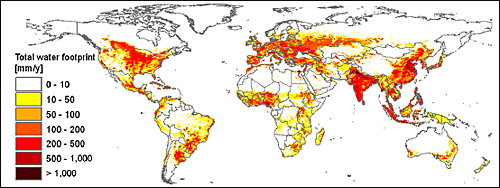Real water use of the average world citizens is an astonishing 4000 liter per day
The average global water consumption has been 1.385 m3/y per capita over the period 1996-2005. This comes down to a average of almost 4000 liter per day. These figures were published in an article that appeared in the Proceedings of the National Academy of Sciences (USA) on February 13.
The authors of this article, Arjen Hoekstra and Mesfin Mekonnen of the University of Twente (the Netherlands) calculated the average water footprint, including not only the domestic water use, but also the use of fresh water for agricultural and industrial use.
Tenfold water use
Normally the figures on average water use per capita are published by water supply companies and refer mainly to domestic use only. Normally these figures do not top a daily use of 400 liters per capita, not even in highly industrialized countries. The new study by Hoekstra and Mekonnen shows that the actual water use is a tenfold.
The study reveals how different products and nations contribute to water consumption and pollution throughout the globe. The authors hope that the findings help governments to establish commodity production and consumption policies aimed at managing the planet’s finite freshwater supplies more effectively.
The water footprint (WF) is measure of the total volume of freshwater used to produce goods and services. The authors estimated the water footprint for an average citizen in each country, using three components:
- blue - the volume of ground and surface water used
- green - the volume of rainwater used
- grey - the volume of freshwater polluted
Industrialized countries have water footprints in the range of 1.250–2.850 m3∕y per capita, whereas developing countries show a much larger range of 550– 3.800 m3∕y per capita.
Fast growing water stress in China
The water footprint of Chinese consumption is still relatively small and largely internal (90%), but given the country’s rapid growth and the growing water stress (particularly in North China), the country is likely to increasingly rely on water resources outside its territory, evidenced by China’s policy already today to buy or lease lands in Africa to secure their food supply.

With 92% the agricultural sector is by far the biggest freshwater consumer.
One-fifth for export
The study shows that about one-fifth of the global WF in the period 1996–2005 was not meant for domestic consumption but for export. The relatively large volume of international virtual water flows and the associated external water dependencies strengthen the argument to put the issue of water scarcity in a global context.
Need for sustainable water policy
For governments in water-scarce countries such as in North Africa and the Middle East, it is crucial to recognize the dependency on external water resources and to develop foreign and trade policies such that they ensure a sustainable and secure import of water-intensive commodities that cannot be grown domestically.
Some other remarkable figures for the average water footprint:
- the global annual average was 9,987 Gm3/y (74% green = consumed rain water), 11% blue (= consumed surface & groundwater), 15% gray (= fresh water needed to assimilate pollution of surface & groundwater).
- the global average consumer used 1,385 m3/y (in USA 2,842 m3/y and in China 1,071 m3/y)
- consumption of cereal products gives the largest contribution to the water footprint (27%), followed by meat (22% and milk (7%)
Read the full article in the website of PNAS.
More information
Water Footprint Network
c/o University of Twente
Enschede, the Netherlands
+31 53 489 4320
www.waterfootprint.org




